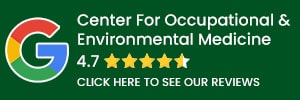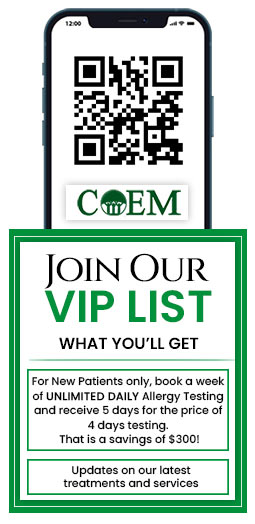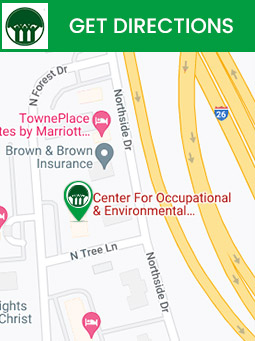Overview of Candida Albicans by COEM in Charleston SC
Candida albicans is a naturally occurring fungus that lives on your body. Overproduction of candida (yeast) can cause infections. Visit The Center for Occupational and Environmental Medicine (COEM) to get a comprehensive diagnosis and treatment. For more information, contact us today or schedule an appointment online. We are conveniently located at 7510 North Forest Drive North Charleston, SC 29420.


By Allan D. Lieberman, M.D.
Dr. Billy Crook (William Crook, M.D.) wrote the Yeast Connection book in 1986. It was one of the first books published on the importance of Candida albicans on the health of men, women, and children. Everyone knew women had yeast, but few realized that yeast infection wasn’t reserved just for women.
Billy was a member of the American Academy of Environment Medicine (AAEM) and had a great deal of influence on the many like-minded physicians who recognized the environment as a major influence on health. I became a member of AAEM in 1978, which changed the course of my life in medicine.
The Yeast Connection brought down the wrath of conventional medicine upon us for treating our patients with anti-fungal medications. We had at the time only Nystatin, one of the safest drugs in the whole Physicians Desk Reference. As time went on, we learned more and more about the role of Candida albicans, as well as the development of new more potent drugs, such as Ketoconazole and Fluconazole.
As many books and medical papers have been written about yeast, it would be difficult to discuss this topic in a few paragraphs. Nonetheless, I would like to share my 33 years’ of experience in this brief report.
Unbeknownst to most people, Candid albicans is part of the normal flora of our bowel. It acts as our body’s own antibiotic against enteric bacteria such as Salmonella, Shigella, and Typhoid fever. However, when we imbalance the microbiological flora of our intestine, that which is good becomes bad.
The one factor that made Candida bad was the introduction of antibiotics, which altered our healthy flora. Our use of steroids and immunosuppressive drugs also contributed to Candida’s imbalance.
Surprisingly, there are probably no signs and symptoms recorded by patients that could not be associated with or caused by Candida, and the symptoms may affect every organ of the body.
The only way you can tell if Candida is the cause, in my experience, is to treat the patient empirically. There are now a few laboratory tests available that can be helpful in suspecting Candida, but even if the results are positive, you will never know if a patient’s problems are related to yeast until you treat it.
There are a few important observations I have found over the years:
1. There is clearly a relationship between endocrine function, especially the ovary, and thyroid, with Candida. That is because there is molecular mimicry between Candida and the tissues of these glands.
2. One of the toughest problems in medical practice is recurrent hives. It is true that the known causes are drugs, yellow dye, food (especially natural salicylates), parasites, and hidden infection. Yet despite a patient being reactive to these many things, yeast eradication using systemic anti-fungal drugs clears the great majority of these patients’ hives.
3. A large segment of my patient population is made up of children with Autism Spectrum Disorders. Whereas heavy metal poisoning is clearly the major cause of altering behavior in these children, yeast cannot be far behind. It never ceases to amaze me how effective systemic yeast eradication is in improving these disorders. As so many of these children have significant allergies, which lead to superimposed infections with massive recurrent use of antibiotics, the prevalence of yeast should really be no surprise. [For further information, see our companion article Yeast-Yet Again!-An Interview]
4. Diet plays a role in the support of our natural good flora-and of yeast. Diets high in simple carbohydrates do promote further yeast, so controlling its overgrowth requires reducing refined carbohydrates and simple sugars.
5. There are many alternative products that can control Candida. These include Oregano, Grapefruit Seed Extract, Olive Leaf Extract, and bicarbonate. I prefer beginning patients on Ketoconazole (Nizoral) or Fluconazole (Diflucan) first because the therapeutic trial is critical to making the diagnosis and establishing the cause. If Candida is the cause, the response is usually rapid and obvious.
6. Some patients are from Missouri and demand to be shown first that they are inhabited by massive yeast before they will start drug therapy. An Organic Acid Analysis, performed on a urine sample, may reveal the presence of specific metabolites that are not of human origin. D-arabinose is specific to Candida, while Citromalic and Tartaric Acid are non-specific to other forms of yeast.
7. Finding physicians willing to test and treat problems of yeast is difficult, except for environmental physicians. The American Academy of Environmental Medicine’s website will provide their names: www.AAEMonline.com
8. There are presently numerous books on yeast, but all of the late Billy Crooks are, in my opinion, some of the best.
Based on 33 years in the practice of Environmental Medicine, it is my opinion that Candida plays a critical role in many of the patients I have treated. Candida should be considered in every patient, especially those patients with multi-system involvement. In my experience, a therapeutic trial using systemic anti-fungal drugs is the only way to identify yeast as a causative factor in the patient’s multiple signs and symptoms.
For more information, contact us today or book an appointment online. We are conveniently located at 7510 North Forest Drive North Charleston, SC 29420. We serve patients from Charleston, Mt. Pleasant, Summerville, North Charleston SC, Ladson SC, Hanahan SC, James Island SC, John’s Island SC, Daniel Island SC, all of South Carolina, Nationally, and Internationally. Patients routinely fly into Charleston to be evaluated by COEM and to enjoy this beautiful city which is a Condé Nast and Travel and Leisure Top Domestic and International Tourist Destination.










